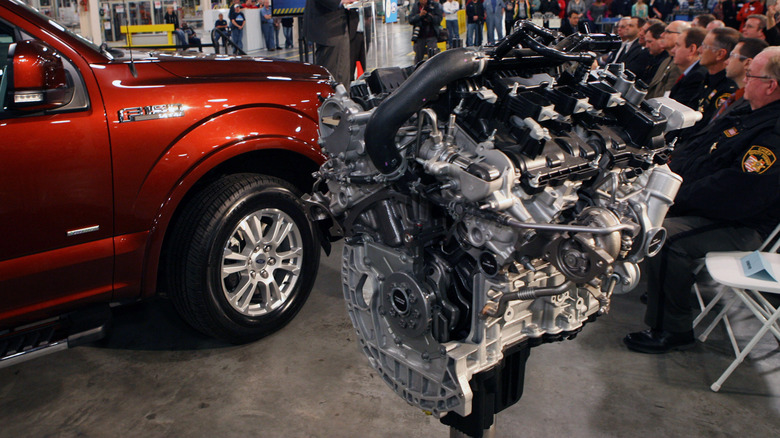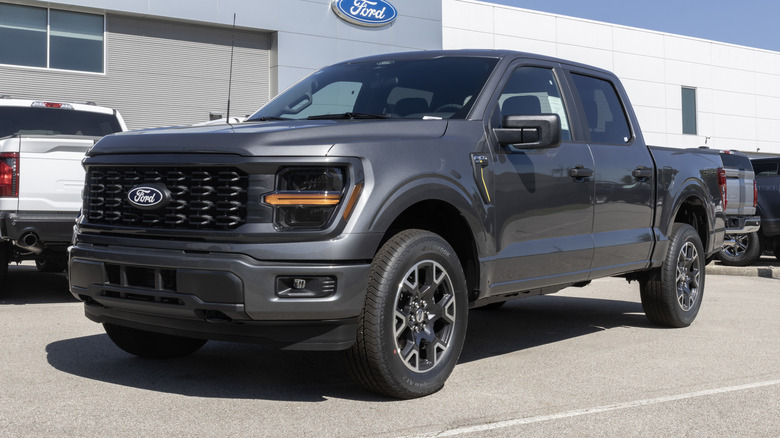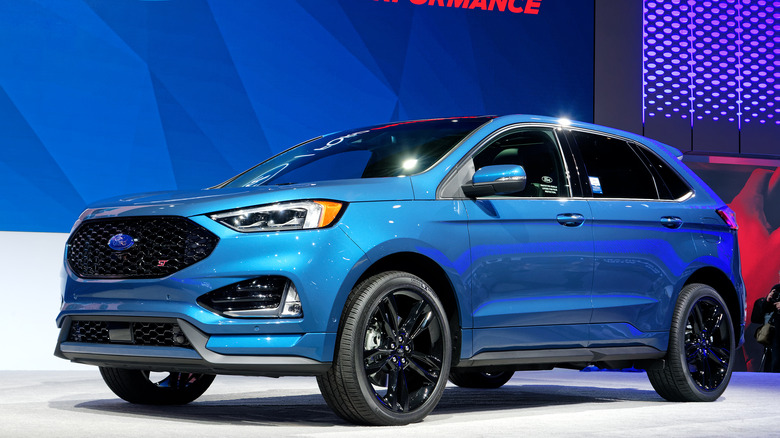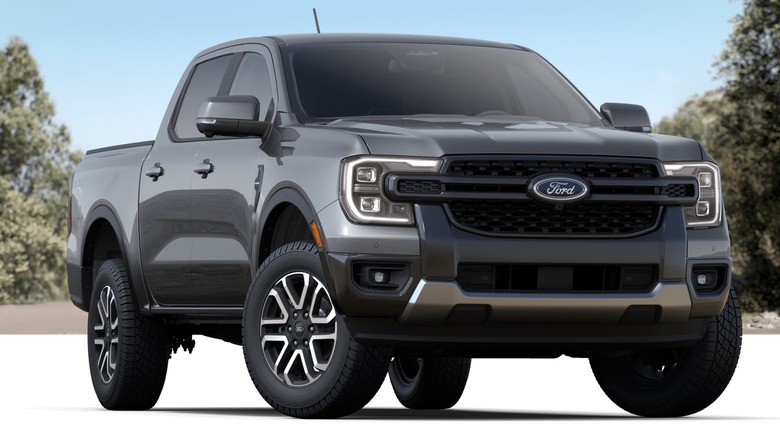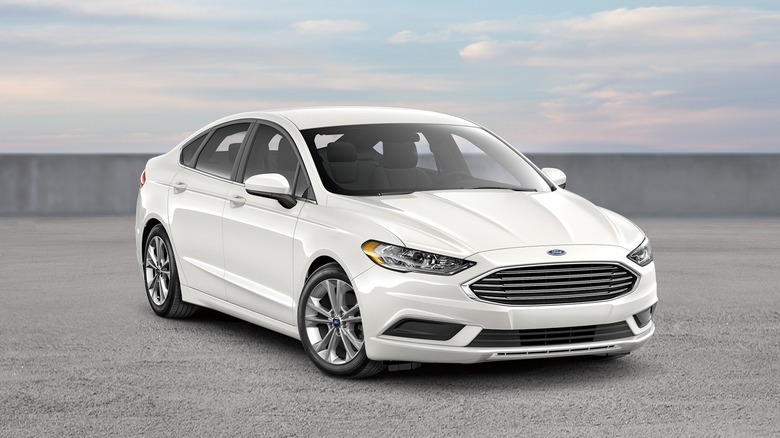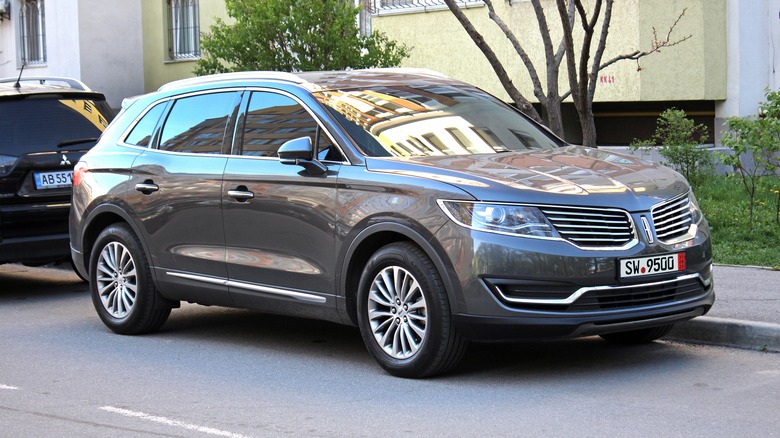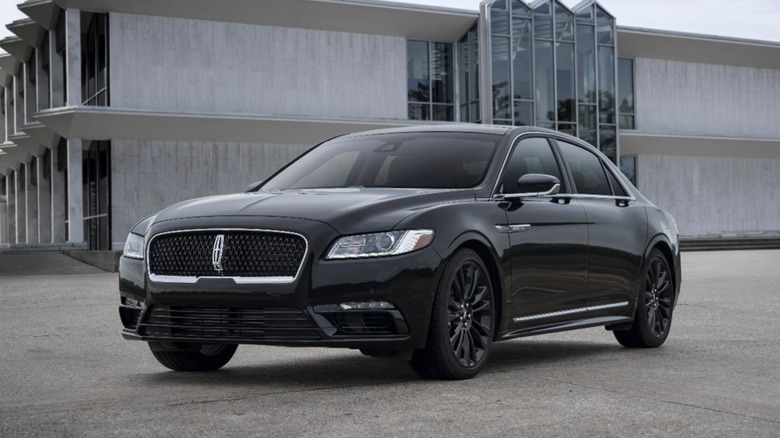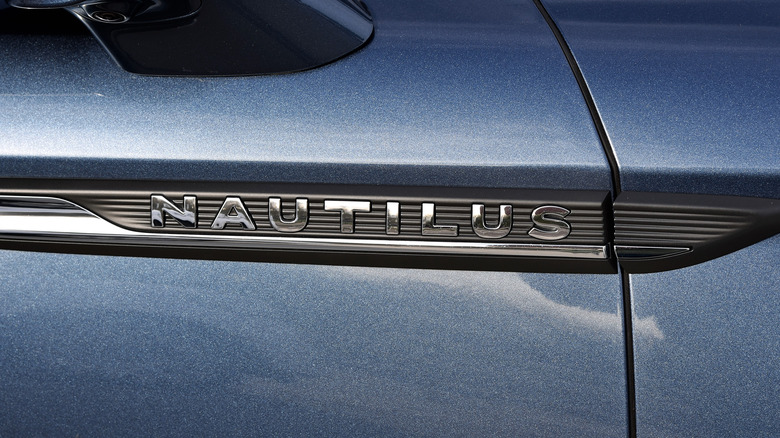Every Ford Model Powered By The 2.7L V6 Ecoboost Engine
One unique aspect of Ford is the company's specialized EcoBoost engines, providing great power while keeping to emissions standards set by governments worldwide. These twin-turbocharged behemoths consistently reach horsepower numbers other engines could only dream of, with Ford models powered by the 3.5-liter engine blowing rivals out of the competition entirely. While that variant of the engine has some impressive results, lower-capacity versions — like the 2.7-liter — are still able to earn their spot when ranking every Ford EcoBoost engine.
Though the 2.7-liter EcoBoost still does a fantastic job, its history is notably less robust than most other versions of the engine. Even after multiple revisions since its introduction in 2015, it was only ever used in a handful of Ford models, with some being discontinued and others removing the engine from its lineup. In spite of this, it still manages to be a staple in some of Ford's most iconic rides, even being added to one line of trucks starting in their 2024 model year. Even while it lacks the wide range of vehicle options shared by other EcoBoosts, it's still worth looking at the 2.7-liter version and all Ford models it was present in.
This article will focus on models and trims specifically boasting the 2.7-liter EcoBoost rather than engines of other makes or capacities. Revised versions of the engine will also be considered alongside the originals, as this didn't always affect their presence in certain Ford vehicles.
Ford F-150 (2015-Present)
One of Ford's most popular products – the F-150 pickup truck — happened to be among the first models to receive the 2.7-liter EcoBoost back in 2015. This engine managed to rival the numbers of a non-EcoBoost 5.0-liter option in the same truck. While it was outdone in acceleration by the 3.5-liter EcoBoost, it outdid the competition when it came to fuel efficiency. 18/23/20 MPG with four-wheel drive is far from a terrible rating, and 325 horsepower is a flat-out unreachable number by other 2.7-liter engines even today. For one of the first forays of the engine into the hands of consumers, it had an unquestionably strong start.
Throughout many revisions of both the truck and the engine, the 2.7-liter EcoBoost remained in the F-150 every following model year. As the 2024 Ford F-150 got more power and a new design, the engine became standard on XL, STX, and XLT versions of the truck after only being standard on the Lariat just one year prior. This happened even without significant changes to the EcoBoost itself, as it didn't gain any significant boosts in horsepower and only got a slight increase in torque since its 2015 debut. While this makes it fall short of more expensive engines, its continued status as a remarkable budget pick for the F-150 is impressive in its own right.
Ford Edge (2015-2024)
Outside of the F-150, Ford's 2.7-liter EcoBoost also made its way to the Edge SUV during its debut year, though it had slightly less horsepower and torque. Still, it could stand toe-to-toe with other SUVs of its class, with reviewers noting its incredible 0-60 mph time of less than six seconds without making too much noise. These impressive results carry over across the vehicle's model years, with the latest one beating its F-150 counterpart with 335 horsepower. That's about as strong as the 2.7-liter EcoBoost has ever been, though it comes at a considerable cost of over $10,000 more than the F-150's cheapest alternative.
The 2.7-liter EcoBoost's time in the Edge has some extra downsides. For one, its availability is far more limited, only being present on the 2024 Edge ST. Additionally, Ford discontinued the Edge to make way for electric vehicles, with one of the primary factories of the Edge being converted for this purpose. With its recent lack of presence in the model, it's unlikely that the 2.7-liter EcoBoost played any part in the Edge's discontinuation. However, this SUV is unlikely to be remembered as one of the hallmark examples of this engine's greatness.
Ford Bronco (2021-Present)
Reviving the Bronco name in 2021, Ford commemorated the classic vehicle's return by equipping it with plenty of modern-day technology. Of course, this included the 2.7-liter EcoBoost, which was made available on almost all early models of the Bronco while providing 330 horsepower and greater torque than both the F-150 and the Edge. While it continues to be present in Bronco models today, it's only available as a standard pick for the 2024 Bronco Wildtrak and an optional choice for the Black Diamond and Badlands models. Splurging on the 2.7-liter does still give you some extra benefits, including the option to control your speed with just a single pedal.
It's not known if the Bronco's next model year will continue to offer the 2.7-liter EcoBoost as an engine option. Our 2023 Ford Bronco Heritage Edition review mentioned the engine's impressive performance while criticizing its price and relatively poor fuel efficiency. As it turns out, this particular engine is no longer available in the 2024 Heritage Edition, and you'll still have to spend quite a bit more for its presence than you would for the F-150. You'll likely be buying the Bronco more for its extra features and unique design rather than the 2.7-liter EcoBoost, but the engine is still a pretty great addition to the vehicle's offerings.
Ford Ranger (2024)
Though the name "Ford Ranger" has been around for a while, 2024 marks the first time it's been outfitted with this particular engine. When the 2024 Ranger was first revealed, Ford also shared the presence of the 2.7-liter EcoBoost under its hood. It isn't available as a standard option. Rather, it is only available in the XLT and Lariat models, and its horsepower is notably lower than previously mentioned vehicles at just 315. Even so, it's the strongest engine option these specific models have, wiping the floor with its 2.3-liter counterpart for a somewhat higher price of around $5,000.
Admittedly, the Ranger is probably the weakest showing of the 2.7-liter EcoBoost for Ford models still in production today. The truck itself is far more expensive if you want this specific engine while offering few benefits compared to its counterparts, and its fuel efficiency compared to the F-150 is simply disappointing. While things aren't looking so great for the engine, it's important to note that the 2.7-liter EcoBoost was always present for at least two years after being introduced in a new model. That trend could be broken in next year's Ranger, but if not, perhaps Ford could focus on further improving this version of the EcoBoost to help it stand out amongst its alternatives.
Ford Fusion (2017-2019)
Interestingly, the Ford Fusion is the only non-luxury Ford model to feature the 2.7-liter EcoBoost without making it to 2024. Ford discontinued the Fusion in 2020, and the last time it had this specific engine was back in 2019. Considering how it was introduced to the model in 2017, this ended up being one of the shortest runs for the 2.7-liter EcoBoost. This run wasn't without its highlights, though, thanks to the fact that the Fusion is a passenger car rather than an SUV or pickup truck.
Throughout the period where the 2.7-liter EcoBoost was present in this vehicle, it was only ever available in "Sport" models of the Fusion. In 2017, though, this still made it one of the cheapest Ford models to boast the engine, even beating out the 2024 F-150's pricing. The specs were remarkably similar, as well, with 325 horsepower and comparable MPG ratings. This price climbed dramatically by its 2019 model year, unfortunately, and the engine didn't even manage to be included in the final Fusion lineup in 2020. Even with the unfortunate events that followed, when simply going by the numbers, the 2.7-liter EcoBoost is still one of the best engines Ford ever put in a passenger car at the time.
Lincoln MKX (2016-2018)
In addition to models under Ford's name, the 2.7-liter EcoBoost found its way into the company's luxury lineup, Lincoln, as well. The 2016 Lincoln MKX was the first of these high-budget vehicles to boast this version of the EcoBoost, but it didn't take long until the lineup rebranded. If you don't include this rebranding, the MKX ties with the Ford Fusion in being the shortest runs for the 2.7-liter EcoBoost, with 2018 bringing the last of these rides to the hands of consumers. Though this amount of time is far from impressive, the actual engine under its hood boasts unmatched power even when compared to other cars on this list.
At 335 horsepower and 380 torque, the 2.7-liter EcoBoost in the MKX ties with the version found within the Ford Edge as the strongest it's ever been. Sadly, the MKX's design hinders its overall performance, with unimpressive 0-60 results stemming from poor suspension and grip. It's no wonder that this vehicle was eventually rebranded into the Nautilus, and under that new name, the 2.7-liter EcoBoost continued to thrive in Lincoln's lineup for years to come.
Lincoln Continental (2017-2020)
Outside of the MKX and Nautilus, the 2.7-liter EcoBoost also found its way into the Lincoln Continental starting in 2017. It shared its specs with both of these other models down to the horsepower and torque, but it surpasses both when it comes to 0-60 times. Notably, this engine was only available standard on Reserve and optional on Select Continentals in 2017, and it only found its way to Reserve models in 2020. The 2020 version is perhaps even more impressive, though, blowing all previous 0-60 times away by half a second, and its MPG performance was able to outdo its rating in real-world tests. Outside of the F-150, this luxury ride is perhaps the greatest example of the 2.7-liter EcoBoost's potential.
After four years, though, the Continental was axed as luxury sedan sales shrank. SUV sales were simply outperforming luxury sedans like this one, leaving it with little room to grow. However, of all cars on this list, the 2020 Continental has the most powerful and capable version of the 2.7-liter EcoBoost, even beating out the Edge and only falling short when compared to the F-150's torque. It might be worth seeking out one of these Continentals if you want to see the full strength of this engine for yourself.
Lincoln Nautilus (2019-2023)
As previously mentioned, Lincoln rebranded the Lincoln MKX into the Lincoln Nautilus for the 2019 model year, and the 2.7-liter EcoBoost remained as one of its engine options. The actual specs of the engine didn't change, but design changes to the vehicle itself allowed the EcoBoost to shine with over a second of improvement in 0-60 times. A common compliment given to this engine across all models is its whisper-quiet sound, and this remains true even with its staggering performance in the Nautilus. It falls short in comparison to the Continental, but this vehicle — and its version of this EcoBoost — is more than a worthy successor to its original MKX version.
Unfortunately, the 2.7-liter EcoBoost was dropped for the 2024 Nautilus, being replaced with a less powerful but more fuel-efficient hybrid engine. This is the last time this engine would appear in Lincoln's lineup unless the company decides to revisit it for future luxury cars in 2025 and beyond. If you want to experience the 2.7-liter EcoBoost for yourself in a 2024 model year vehicle, your only option is to see how it handles in a Ford truck or a non-luxury SUV.
